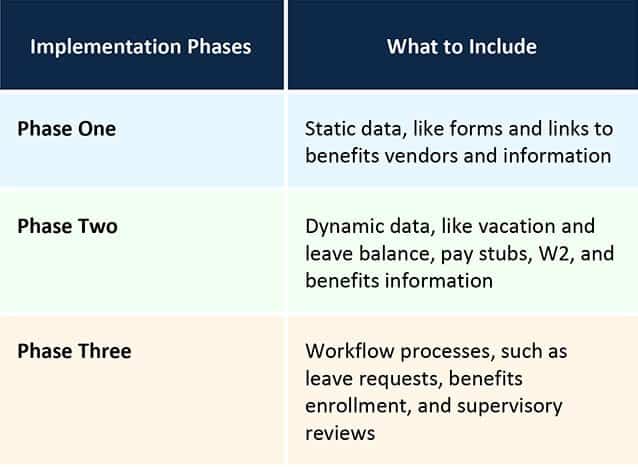What Is a Human Resource Portal?
A human resource portal, or HR portal, is an internal gateway for a company’s employees to access HR-related and other information about their workplace. It is also an access point for outside job applicants and potential applicants. HR portals are usually dynamic and interactive and should not function only as repositories for benefits and other workplace information.
The goal of an HR portal is to streamline and centralize information so that it is easy for employees to find what they need. For example, if handbooks, benefits enrollment details, and other information are on a portal, a company can save money by reducing printing costs and staff hours in distribution. (HR portals are frequently secure, so existing employees usually must have login credentials to access company information.)
HR portals can also help connect human resource staff to employees (and vice versa) as well as reduce calls and emails between the two. If employees can find the information they need on their own, they do not need to involve HR staff.
Those changes can involve making sure that the data employees input is accurate and interacts correctly with the portal. “The focus [of HR staff] can change to working on the system to deliver better information to the employee. You enhance the employee experience by making more accurate information available. You manage the system, not the data itself,” White-Evans explains.
Why Are Human Resource Portals Necessary?
Happy and engaged employees are often better workers than disgruntled ones. Marketing research company the Hay Group found that motivated and engaged employees were 43 percent more productive than others who were less satisfied.
The Hay Group measured employee satisfaction using a diagnostic survey at 10 offices of a professional services firm. People in the five most engaged offices had a 43 percent higher generated revenue than the five least engaged offices.
“The HR portal is another way for a company to interact with its employees,” White-Evans points out. “I can see where the more often you connect to your company in a positive way, the more the company builds loyalty. [An HR portal] is an untapped area, and there are a lot of companies that can grow with it,” she emphasizes.
With today’s employees seeking a balance between their work life and personal life, keeping an employee happy and productive is key to retaining them. Using data from a Gallup Organization study, the Harvard Business Review determined that employee turnover and absenteeism at highly engaged companies is 25 percent lower than at companies that are less active in promoting employee engagement. Higher engagement companies also reported 48 percent fewer safety incidents and 41 percent fewer quality incidents, often because engaged employees are more attentive and vigilant. It’s simple: When people can see how they contribute to their company, they want to come to work.
In fact, HR portals can help drive that engagement. “Whether it’s improving internal communications, giving staff an organizational voice in a blog or survey, publicly acknowledging employees for a job well done, or simply giving them easy access to the tools necessary to complete the work, the HR portal has a major contribution to make on a number of fronts,” says McMinn.
What Items Are Often on a Human Resource Portal?
When thinking about what to include on an HR portal, consider the information employees need to do their jobs within a company’s environment. The portal should make it easy for employees to find the information they need without having to contact the human resources department. It can also help them engage with other employees.
Often, HR portals are part of a company’s larger intranet system. These portal items could include, but are not limited to the following:
- Onboarding and Introduction Packets: When beginning a new job, it’s difficult to remember everything the onboarding person told you. A packet on the portal can be a good place to refer new employees who need information. It can also be a place for existing employees to refresh themselves on the basics.
- Policies and Procedures: This can include handbooks, company values, forms, social media policies, diversity policies, and grievance procedures.
- Job Descriptions and Recruitment Processes: This section includes information about salary and performance reviews, organizational charts, payroll information, and internal vacancy notices.
- Benefits and Entitlements: A place for all information about benefits and fringe benefits, including insurance, wellness incentives, retirement plan information, annual leave procedures, and discount programs.
- Staff Directory and Bios, Maybe With Photos: This is a place for employees to interact via messaging or a similar tool.
- Links to company news and announcements: Use this section to disseminate new information and developments about the company.
Chances are, people who work in HR answer the same questions repeatedly. The list differs depending on the company, but inquiries often revolve around sick leave, insurance, and retirement plans. An FAQ section on the portal could help HR staff provide answers to these questions.
Chatham Financial uses their HR portal mainly for forms, and the company uses other online services to connect employees to each other and distribute information. There is an HR section on the company’s intranet system, which is behind a firewall, and the organization uses several methods of communication to push employees to their HR portal for forms and other information. “We end up duplicating a good bit of information trying to get the word out, but we need to meet employees where they are,” Evans says.
This push to get information to employees when they need it can help make your staff more satisfied.
“Relying on colleagues to provide information can be a frustrating business. I’m sure we can all recount stories of a team member who dragged their heels on supplying that crucial bit of data you needed to complete a task,” McMinn says. “The self-service approach offered by an HR portal means that staff can often bypass that colleague altogether and get the information directly at exactly the right time. In fact, being able to do so is liberating and enhances that sense of achievement and satisfaction we all get when we know we’ve done a good job,” he advises.
What Is an Employee Portal?
Employee portals — also called enterprise, intranet, or employee self-service portals — often simply provide a way for employees to stay connected and updated about an organization, and generally contain basic employee tools. Like HR portals, they are usually secure and require login credentials.
Sometimes, employee portals provide a space for social networking and interaction within an organization. They can connect people in different departments and provide photos and contact information so people can know who they are working with. This is an especially important feature for larger companies with multiple locations or for remote workers.
They’re also a valuable project management tool, as they provide a place to store files, manage forms, keep group calendars, publish directories, and build knowledge bases. You can also use employee portals to handle tasks, like filing expense reports and mileage logs, registering for events, and booking rooms.
Although employee portals are not the same as human resource portals, they often contain some similar information. However, employee portals are usually not for human resource tasks, such as tracking leave, providing benefits information, or downloading HR documents. To use an existing human resource portals as an employee portal, you should provide some form of employee interaction and engagement.
The Evolution of Human Resource Portals
Human resource portals have come a long way in a short period of time. They began as a way to reduce paper and printing costs by providing a list of links to handbooks, vendors, and company information. Now, they are promoting self-service and are often interactive and personal.
The pace at which a portal grows is often based on the company itself. “There is a difference based on the culture of an organization. There is a big cultural shift here. Some companies are very slow to open up the firewall to information,” White-Evans says. Companies have long held their data behind closed doors and firewalls, and allowing access to employees — many of whom work remotely — is new to them. Thanks to smartphones and other technology, people are now used to having information at their fingertips, and many big companies’ internal technology has not kept up the pace.
“It used to be that the best information was inside companies. Now, the technology is driven by the smaller computer market, and its driving inwards into an organization,” White-Evans says. “The consumer market has outpaced the internal technology that is currently used in a lot of organizations. People are used to using portals and having access to information, and they are very surprised when they go into a company and the technology doesn’t match what they can do on their phones,” she says.
An HR portal can often make up for shortfalls in company technology, since it is usually an add-on to in-house technology. Many portals are now places for collaboration and employee interaction. People can sign up for benefits, request leave, fill out forms, apply for promotions, fill out performance reviews, and much more.
Key Traits and Functionality of a Human Resource Portal
The goal of the HR portal is to provide a place where employees go to get the information they need for a variety of functions. It doesn’t do much good if the employees don’t utilize it, so you should know the basic functions most HR portals have.
If the HR portal is also the place for job applicants and potential job applicants, there needs to be a difference between what current employees see on an intranet and what people on the outside see via the internet.
“When it comes to recruitment, it’s a very competitive world out there, and every company needs to put their best foot forward if they want to attract top applicants. An HR portal is one way to really showcase your company at its best by providing a seamless service to applicants,” McMinn says. “It offers a single point of access and source of knowledge for applicants. And, for the company, it makes the task of managing recruitment much easier and more cost-effective,” he recommends.
Once the company hires someone as part of the team, that new employee can have access to onboarding materials (documents, videos, presentations, etc.) via the portal. You’ll find onboarding best practices in this article, and free onboarding checklists and templates here.
HR portals can also be the place for employees to automate certain tasks, like updating personnel records, booking leave, submitting expense reports, and completing other administrative tasks.
HR portals should be customer-friendly and designed for the user (employee), not for the people working in HR. The portals should be intuitive and easy to navigate.
“Ours has website-like navigation, which hopefully makes it easier for employees to find what they want. Menu navigation is pretty critical,” Evans shares.
For example, Chatham Financial’s HR portal contains the following headers:
- HR: Payroll, benefits, policies, org chart, time- off tracking
- Learning and Development: Training, performance review, internal mobility
- Culture and Leadership: Leadership team, leader blog, annual engagement survey
- Offices: Office-specific info for each office location
- Travel and Expenses: Travel information, expense/reimbursement
Many portals also serve as an access point for third-party vendors, like insurance companies, retirement plans, and other benefits vendors. Decision-support tools to help employees compare benefits, learn about options, and estimate costs are also helpful. A video to explain open enrollment could live here instead of in a lengthy document outlining procedures.
Security is also important because the portals contain private information, like social security numbers, contact information, performance reviews, salary history, and other data. Since login credentials are necessary to protect this information, the portal can also be personalized and can have different information available to people based on location, job function, age, and other factors. Managers and supervisors can have access to performance review and leave approval information.
Information on the portal needs to be up to date, so someone needs to monitor and update the site as necessary. The portals can also be a way for HR to push information out to employees, discuss current issues, and answer questions people might have. The information could be in one of many forms, including a blog, a forum, or a newsletter. Providing two-way communication is especially important for remote workers who might never see a representative from HR.
HR portals can also be a place for collaborative work and project management. Promoting that interaction and participation can help empower workers.
Here are a number of ways to engage employees:
- Quizzes, Surveys, and Opinion Polls: These are fun ways to gather feedback from staff while giving them a voice.
- The Celebration of Successes: Allowing people to discuss milestones promotes a positive work environment. Use the portal to post customer testimonials, identify the employee of the month, or celebrate achievements outside of work.
- Professional Development: Help employees further their careers by promoting and providing training opportunities.
Over the years, human resource departments have had to adapt to the changing workplace, and now portals are having to do the same. “Traditionally, HR has been all about the people side of organizations, and every business is founded on good personal relationships between employees. Otherwise, how can you get anything achieved? Today’s workplaces are significantly different from 50 years ago. Technology means that more employees are working remotely or on flexible hours, often in different cities or even countries,” says McMinn.
HR portals are overcoming some of the issues presented by physical distance by simulating the closeness if people working in proximity. “Nowadays, promoting a sense of community among employees is a real challenge, and HR portals can make all the difference. Lots of companies are using social features on their HR portals to promote that sense of camaraderie, despite the many miles that may be between staff members,” says McMinn.
How Do You Create a Human Resource Portal?
An HR portal is only worthwhile if people use it, so designing it with the user in mind is critical. Using good website design, not just a list of links, is crucial. Make it easy to navigate and search. Also, decide whether or not the portal needs to be in multiple languages.
HRPMO’s White-Evans suggests planning what your company wants the portal to do before looking at software or a design partner. “It’s such an easy way to waste money and time if a company does not proactively plan their goals for the HR portal,” she says. “Think about the experience you want to provide, and then back up from that plan and consider the resources you need for the project,” she insists.
White-Evans also recommends taking a look at existing technology and the quality of the data and databases before investing in a portal. If the data itself is not in good shape, it can not go correctly into a portal. “If your business practices are cumbersome, complex, and manual, that’s not a good foundation on which to build a portal,” she says.
The HR portal should have a brand, one that aligns with the overall strategic plan for the company. Consider naming the portal, and give it an identity to help employees see it as an authority on all things human resources.
“I think branding is critically important in this day and age when people expect a good user experience. It needs to look pretty and function well. I think most companies would want to have their logo on there,” Chatham Financial’s Evans says.
Even though the portal is mainly for human resource purposes, other departments might have needs that could become part of the portal. Therefore, getting input from them early in the creation process is vital. Moreover, it is imperative to get the information technology department involved. They can help the HR department decide if the portal should be on-premise or cloud-based software, among other technical considerations.
“You might have multiple types of subject matter experts involved in the HR portal design,” White-Evans advises, adding that it is important to include people from departments who might contribute data to the portal, such as payroll and finance.
Implementing a Human Resource Portal
Remember, the goal of the HR portal is to have employees help themselves to the answers they need when they need them. Once up and running, the portal should be the go-to place for employee information, so taking away alternatives is one way to force employees to use the portal. One idea is to make the portal the only way to accomplish certain tasks, like registering for benefits or finding out about company news.
White-Evans suggests rolling out a portal in phases. “I’d gradually implement it with a solid foundation,” she says, warning that putting a portal online that isn’t ready or doesn’t work can damage a company’s reputation.
Here is an example of how you could design the implementation phases of your HR portal:
When the portal first goes live, you may need a help desk to address employees’ many questions and make them feel comfortable using the new self-service tool.
Evans says her company measures success by the number of requests for information her HR staff receives. Fewer requests mean people are finding what they need on their own.
Track the success of the portal by looking at usage data and analytics. How are employees using the portal? How long are they spending on it? Do they go there voluntarily or just when a specific link tells them to? Tracking patterns of use will help you figure out what you should add or remove from the portal.
On the future of HR portals, McMinn says, “The power of big data is an issue I’m excited to see play out. The inter-relationship between HR portals and big data will be important and has the potential to give HR professionals insights and concrete information that will really impact their work. There’s no doubt, there are very exciting times ahead for HR portals.”
Creating a timeline for the project can help keep implementation on track and foster accountability.
Keep Teams Informed and Productive with Smartsheet Portals
Empower your people to go above and beyond with a flexible platform designed to match the needs of your team — and adapt as those needs change.
The Smartsheet platform makes it easy to plan, capture, manage, and report on work from anywhere, helping your team be more effective and get more done. Report on key metrics and get real-time visibility into work as it happens with roll-up reports, dashboards, and automated workflows built to keep your team connected and informed.
When teams have clarity into the work getting done, there’s no telling how much more they can accomplish in the same amount of time. Try Smartsheet for free, today.



